
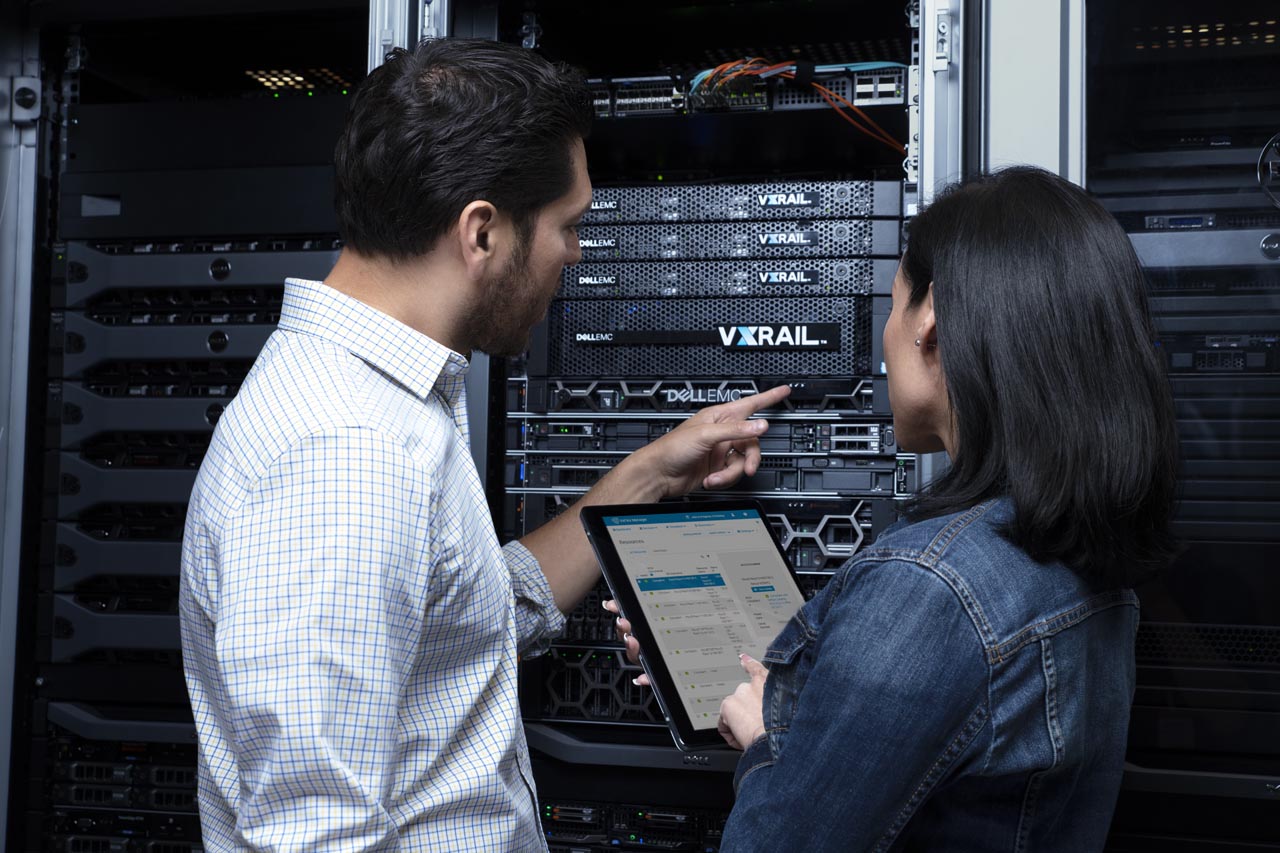
Learn more about the latest major VxRail software update: VxRail 7.0.240
Wed, 24 Apr 2024 12:00:32 -0000
|Read Time: 0 minutes
In a blink of an eye, September is already here. All those well-deserved August holidays have come and gone. As those summer memories with colorful umbrella drinks in hand fade into the background, your focus now turns to finishing this year strong. With the recent announcement on the latest VxRail software release, VxRail is providing the juice to get you well on your way.
VxRail HCI System Software version 7.0.240 has arrived with much anticipation as it includes the expansion of the VxRail product portfolio in the form of VxRail dynamic nodes and significant lifecycle management (LCM) enhancements that our VxRail customers will surely appreciate. Dynamic nodes extend the spectrum of use cases for VxRail by addressing more workload types. The LCM enhancements in the latest software release add to the operational simplicity that VxRail users truly value by increasing the level of automation and flexibility to ensure cluster integrity throughout the life of their cluster.
VxRail dynamic nodes
As VxRail dynamic nodes were described in the external launch event, they benefit customers who are committed to continue running their mission-critical data-centric workloads on Dell EMC storage arrays because of the enterprise-level resiliency and data protection capabilities but value the operational certainty that VxRail offers to their IT teams. This use case can be particularly relevant for customers who have standardized on VCF on VxRail as their infrastructural building block for their cloud operating model. These scenarios can apply to financial and medical industries among many others. For some customers, scaling of storage and compute independently in their HCI environments can better suit some of their application workloads, whether it is a better use of resources or potential reduction in license costs for compute-intensive workloads like Oracle.
Piqued your interest? Let’s move deeper into the technical details so you can better understand how VxRail dynamic nodes address these use cases.
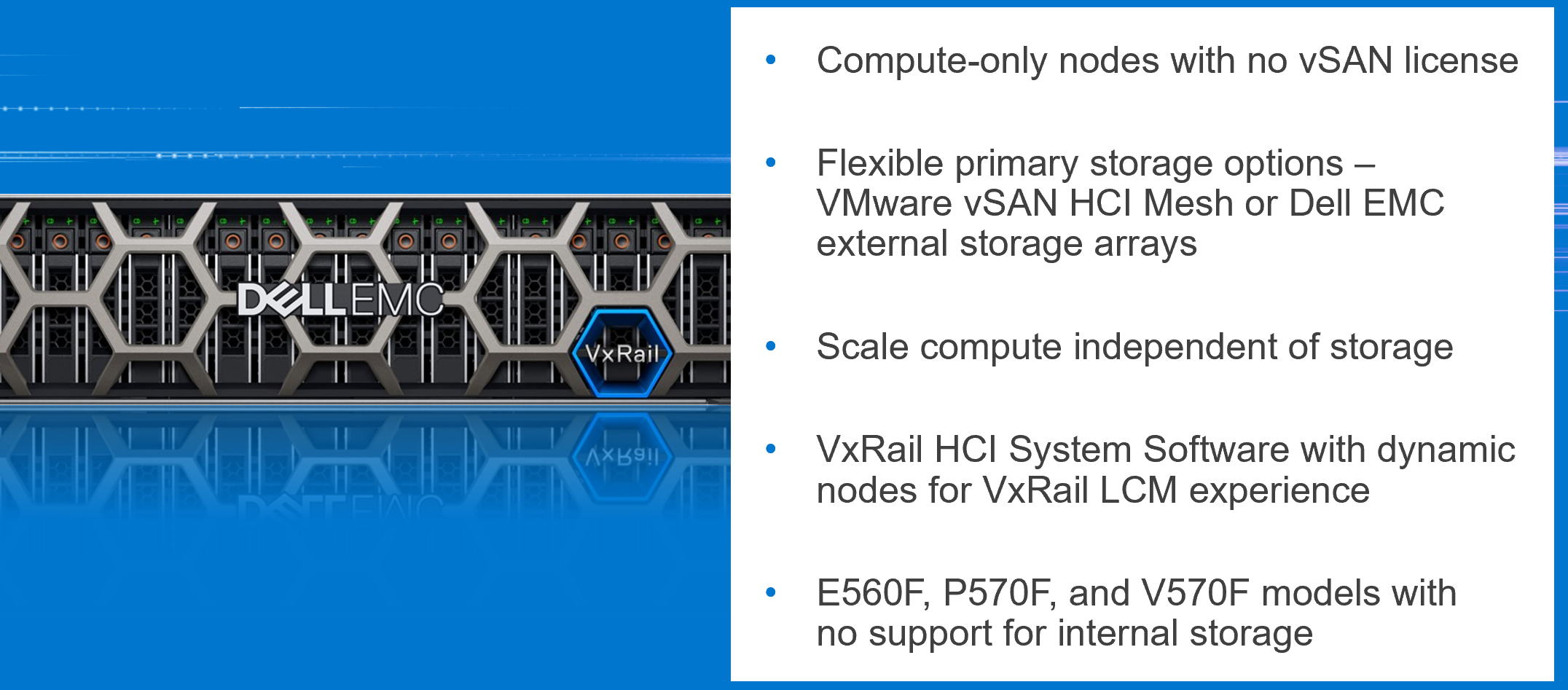
Figure 1: VxRail dynamic node offering
- VxRail dynamic nodes are compute-only nodes running vSphere. Dynamic nodes run VMware ESXi with vSphere Enterprise Plus licenses but do not have vSAN licenses.
- They do not have any internal drives. As a result, the VxRail Manager VM runs on an external datastore that can come from either Dell EMC storage arrays (PowerStore-T, PowerMax, and Unity XT) or VMware vSAN HCI Mesh. Customers can now scale their compute and storage independently while some customers can continue to leverage their Dell EMC storage arrays for enterprise-level resiliency options.
- Dynamic nodes run on the same VxRail HCI System Software as any other VxRail cluster. The same intelligent LCM experience backed by VxRail’s Continuously Validated States exists in dynamic nodes.
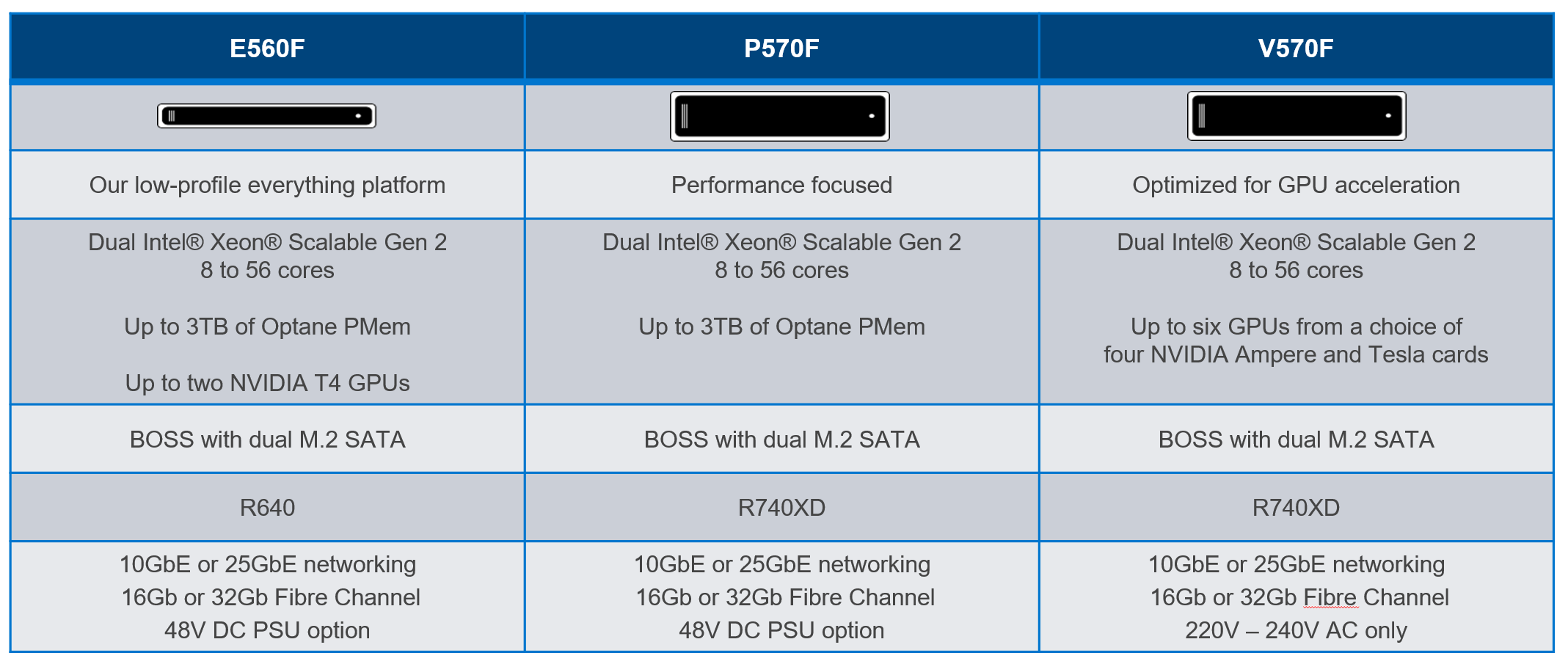
Figure 2: VxRail dynamic node platforms
Like the three-flavor Neapolitan ice cream tub, there’s a flavor of dynamic nodes to match each application requirement. While there are not any cache and capacity drives on dynamic nodes, all other hardware configurations on these models are available. The E-series is the space-efficient 1U platform. The P-series is the performance-focused platform. The V-series is optimized for GPU-acceleration with up to six GPUs per node.
For those wanting to use their Dell EMC storage arrays with these brand-new VxRail dynamic nodes, here are some important pieces of information to consider.
- With VxRail 7.0.240, Dell EMC PowerStore-T, PowerMax, and UnityXT are the supported external arrays for this use case. Third-party storage arrays are not supported.
- Storage connectivity is through Fibre-Channel, either 16Gb or 32Gb Dell EMC Connectrix Brocade or Cisco MDS FC switches.
- Management of the storage array and Fibre-Channel switch is done separately including lifecycle management, zoning, and provisioning of storage. VxRail HCI System Software is responsible for the LCM of the dynamic nodes themselves.
- When deploying a dynamic node cluster, the datastores need to be already provisioned and zoned to the dynamic nodes.
- The storage array and dynamic nodes are sold separately and supported discretely by Dell Technologies.
LCM Enhancements
Now let’s move onto the LCM enhancements in VxRail 7.0.240. There are three notable enhancements that VxRail users will notice – unless their thoughts have drifted away into those summertime memories.
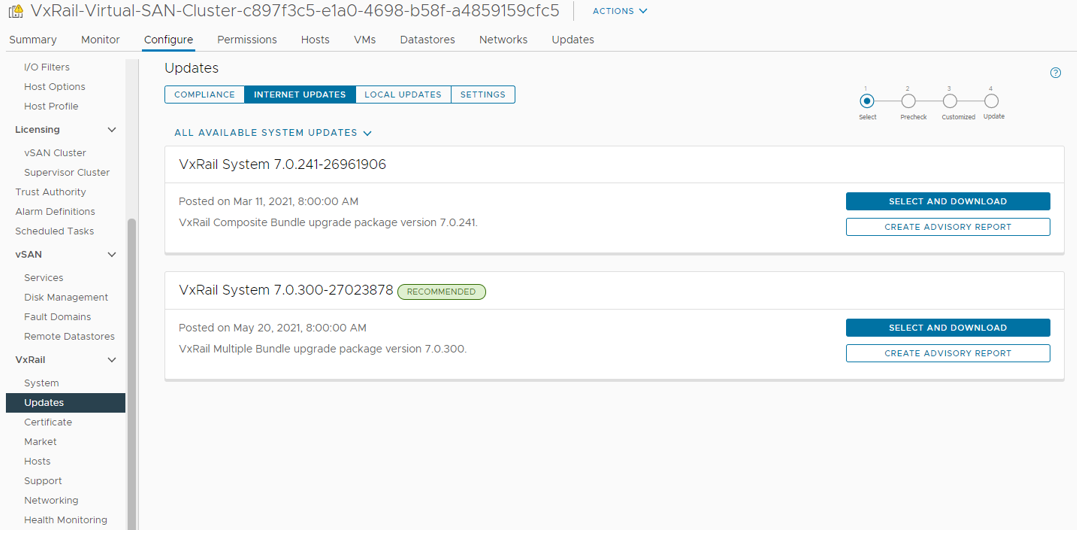
Figure 3: Update advisor
First, update advisor is a new tool to help you plan for their next cluster update. From the Updates > Internet Updates tab, you can now see a list of available update paths for their specific cluster. This feature does not replace your responsibility to review the release notes and decide on to which version to update their cluster but, it does generate an advisory report with critical information to let you know what needs to be updated based on your cluster’s current Continuously Validated State. Update advisor is a helpful tool to plan your maintenance window.
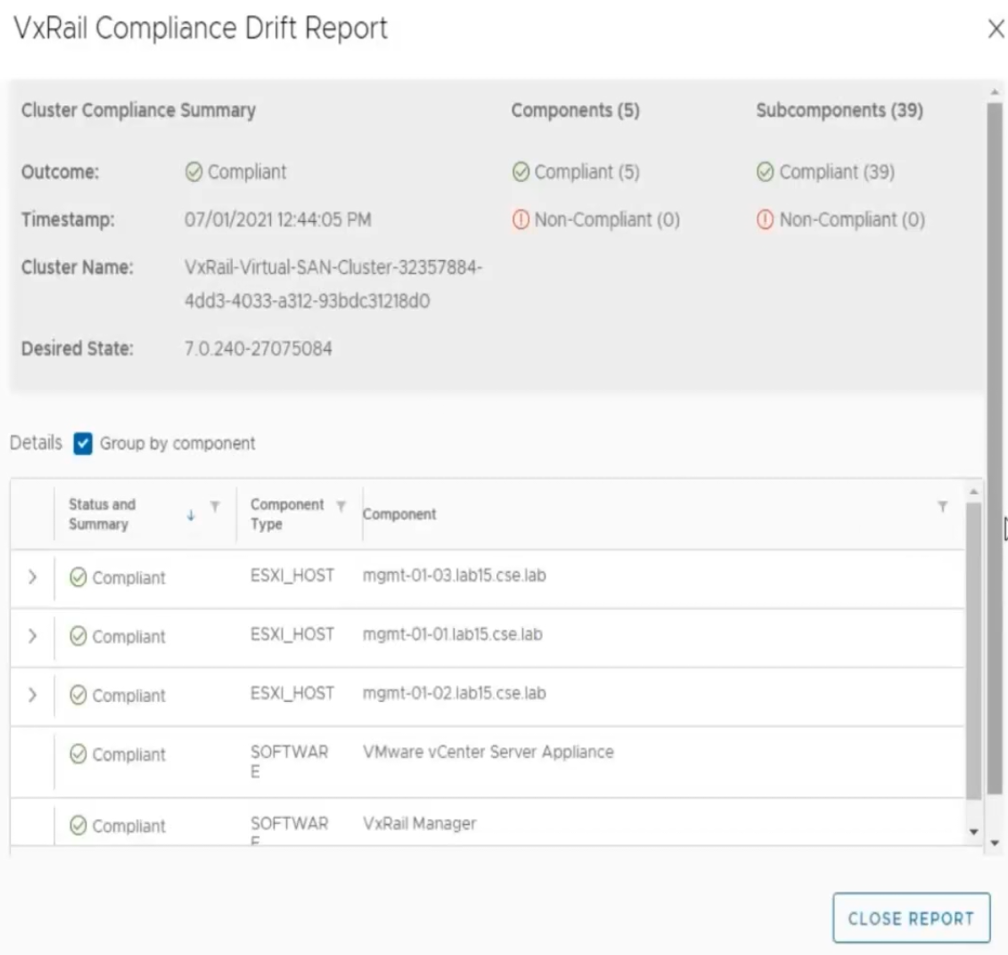
Figure 4: Sample compliance drift report
Second, VxRail Manager now has a compliance checker that will detect any unforeseen version drift from the current Continuously Validated State running on your VxRail cluster. As shown on the image above, it provides a component-by-component report as part of the compliance check. It is run daily by default and can be initiated on-demand.
The third LCM enhancement is VxRail LCM compatibility with VMware vSphere Lifecycle Manager (vLCM).
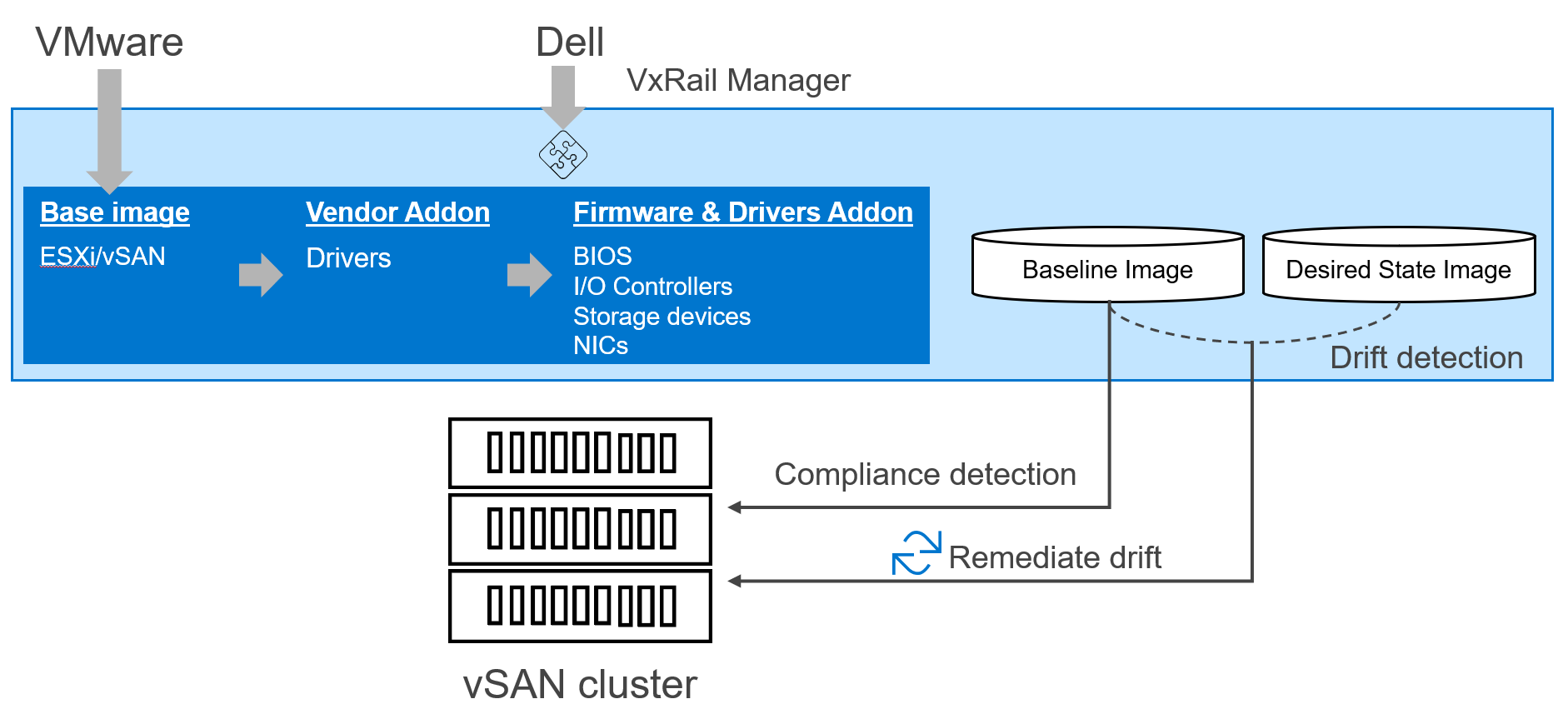
Figure 5: VMware vSphere Lifecycle Manager vLCM framework
As a refresher, VMware vLCM was introduced in vSphere 7.0 as a framework to allow for software (ESXi) and hardware (firmware and drivers) to be updated together as a single system. VMware supplies the base image which is the ESXi image, and then it is up to the hardware vendors, like Dell Technologies, to provide the hardware support manager that plugs into that framework to supply the necessary firmware and drivers and to update them. Together, they form the baseline image which is used for the compliance checker. When updating the cluster, a desired state image is built from a combination of VMware-provided ESXi image and vendor(s)-provided firmware and drivers. Based on the drift detection analysis between the baseline and desired state images, vLCM will remediate the hosts on the cluster to complete the update.
VxRail’s newly introduced vLCM compatibility enables the VxRail Manager VM to plug into the framework to perform cluster updates using VxRail-provided desired state images in the form of Continuously Validated States. Essentially, VxRail has automated the hardware support manager plugin setup and exporting the depot of firmware and drivers to vCenter, which is a very manual process for other HCI solutions. While other hardware support manager plugins to vLCM require a multiple-step procedure to establish a baseline image and desired state image and interaction with multiple interfaces, VxRail’s implementation leverages the vLCM APIs to truly obfuscate those complexities into a streamlined experience all within VxRail Manager. Because VxRail Manager already stores the Continuously Validated State on its VM, the process of identification and exporting of the hardware firmware and drivers on the VxRail stack can easily be automated. The simplicity of VxRail’s support for vLCM cannot be understated.
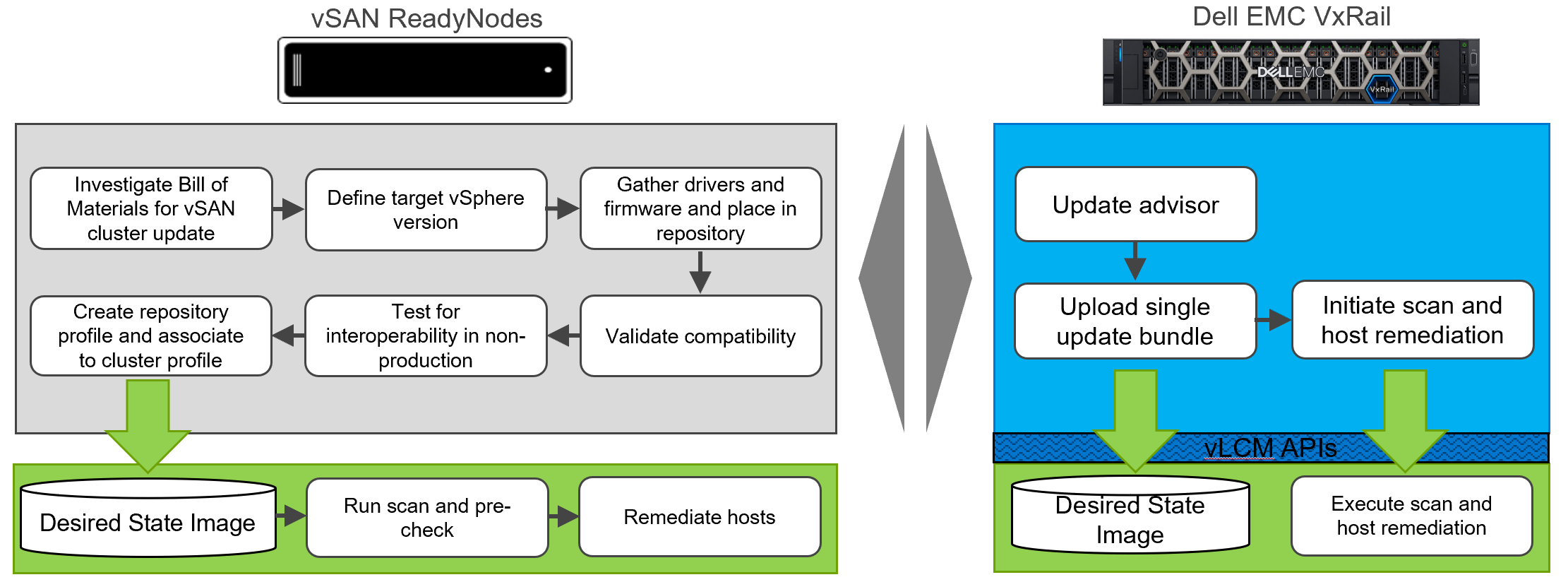
Figure 6: VxRail’s vLCM implementation automates and simplifies the user’s cluster update experience
Similarly, performing cluster updates is a streamlined process once the LCM bundle is downloaded onto the VxRail Manager VM. From VxRail Manager, via the vLCM APIs, the bundle is loaded onto the vLCM framework as the desired state image. In short, vLCM compatibility is mostly transparent to the user as the LCM experience still runs through VxRail Manager.
The next likely question is why offer this enhancement? The explanation can be conveyed in two points both related to cutting down the time to update the cluster.
- Consolidate VMware software updates – for users that already run NSX-T or vSphere with Tanzu, vLCM allows for those VIBs to be included into the desired state image. Instead of updating each VMware software separately, they can be done together in a single boot cycle.
- Consolidate non-VxRail managed components – there are a few components such as the FC HBA that are not part of Continuously Validated State. Those components would then need to be updated separately which may require additional host reboots. The vendor addon feature in vLCM, as shown in the image above, provides the capability to include component firmware/drivers into the cluster image for a consolidated update cycle. Using vLCM APIs, VxRail has incorporated the vendor addon feature into its vLCM implementation in VxRail Manager.
By introducing vLCM compatibility into VxRail LCM, users can benefit from these cool capabilities. With VxRail 7.0.240, the use of vLCM is disabled by default. Users can choose to enable vLCM immediately or enable it later. Developing vLCM compatibility is also a strategic decision to put VxRail in a position to enhance more vLCM capabilities as they come.
Conclusion
VxRail 7.0.240 is a monumental software release that expands the breadth of the VxRail portfolio’s reach in addressing workload types with VxRail dynamic nodes and its depth by enhancing is differentiated LCM experience by providing more ways to ensure cluster integrity and to improve cluster maintenance times. Though the summer is drawing to a close, VxRail is providing you the boost to stay dynamic and finish 2021 strong. Keep an eye out for more content about the latest VxRail release.
For more information about VxRail dynamic nodes, you can check out the VxRail launch page: https://www.delltechnologies.com/en-us/events/vxrail-launch.htm.
If you want to learn more about how VxRail LCM differentiates itself from other HCI vendors using VMware vLCM, you can read these previously posted blogs:
Exploring the customer experience with lifecycle management for vSAN ReadyNodes and VxRail clusters
How does vSphere LCM compare with VxRail LCM?
Author Information
Daniel Chiu, Senior Technical Marketing Manager at Dell Technologies
Related Blog Posts

Learn About the Latest Major VxRail Software Release: VxRail 7.0.450
Thu, 11 May 2023 16:14:15 -0000
|Read Time: 0 minutes
To our many VxRail customers, you know that our innovation train is a constant machine that keeps on delivering more value while keeping you on a continuously validated track. The next stop on your VxRail journey brings you to VxRail 7.0.450 which offers significant benefits to life cycle management and dynamic node clusters.
VxRail 7.0.450 provides support for VMware ESXi 7.0 Update 3l and VMware vCenter 7.0 Update 3l. All existing platforms that support VxRail 7.0 can update to 7.0.450.
This blog provides a deep dive into some of the life cycle management enhancements as well as PowerStore Life Cycle Management integration into VxRail Manager for VxRail dynamic node clusters. For a more comprehensive rundown of the features introduced in this release, see the release notes.
Life cycle management
The life cycle management features that I am covering can provide the most impact to our VxRail customers. The first set of features are designed to offer you actionable information at your fingertips. Imagine taking your first sip of coffee or tea as you log onto VxRail Manager at the start of your day, and you immediately have all the up-to-date information that you need to make decisions and plan out your work.
VxRail pre-update health check
The VxRail pre-update health check, or pre-check as the VxRail Manager UI refers to it, has been an important tool for you to determine the overall health of your clusters and assess the readiness for a cluster update. The output of this report brings helps you to be aware of troublesome areas and provides you with information, such as Knowledge Base articles, to resolve the issues. This tool relies on a script that can be automatically uploaded onto the VxRail Manager VM, if the cluster is securely connected to the Dell cloud, or manually uploaded as a bundle procured from the Dell Support website.
For the health check to stay reliable and improve over time, the development of the health check script needs to incorporate a continuous feedback loop so that the script can easily evolve. Feedback can come from our Dell Services and escalation engineering teams as they learn from support cases, and from the engineering team as new capabilities and additions are introduced to the VxRail offering.
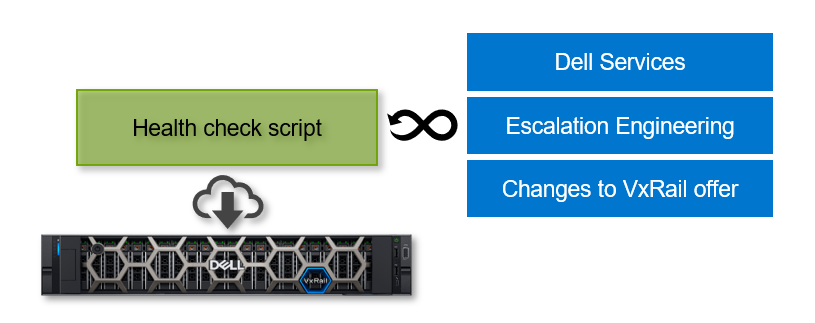
To provide an even more accurate assessment of the cluster health and readiness for a cluster update, the VxRail team has increased the frequency of how often the health check script is updated. Starting with VxRail 7.0.450, clusters that are connected to the Dell cloud will automatically scan for new health check scripts multiple times per day. The health check will automatically run every 24 hours, with the latest script in hand, so that you will have an up-to-date report ready for your review whenever you log onto VxRail Manager. This enhancement has just made the pre-update health check even more reliable and convenient.
For clusters that are not connected to the Dell cloud, you can still benefit from the increased frequency of health script updates. However, you are responsible for checking for any updates on the Dell Support website, downloading them, and staging the script on VxRail Manager for the tool to utilize it.
VxRail cluster update planning
The next enhancement that I will delve into provides a simpler and more convenient cluster update planning experience. VxRail 7.0.450 introduces more automation into the cluster update planning operations, so that you have all the information that you need to plan for an update without manual intervention.
For a cluster connected to the Dell cloud, VxRail Manager will automatically scan for new update paths that are relevant to that particular cluster. This scan happens multiple times a day. If a new update path is found, VxRail Manager will download the lightweight manifest file from that target LCM composite bundle. This file provides the metadata of the LCM composite bundle, including the manifest of the target VxRail Continuously Validated State.
The following figure shows the information of two update paths provided by their manifest files to populate the Internet Updates tab. That information includes the target VxRail software version, estimated cluster update time, link to the release notes, and whether reboots are required for the nodes to complete an update to this target version. (You can disregard the actual software version numbers: these are engineering test builds used to demonstrate the new functionality.)

VxRail Manager, by default, will recommend the next software version on the same software train. For the recommended path, VxRail Manager automatically generates an update advisor report which is the new feature for cluster update planning. An update advisor report is a singular exportable report that consolidates the output from existing planning tools:
- Same metadata of the update path, as provided on the Internet Updates tab:
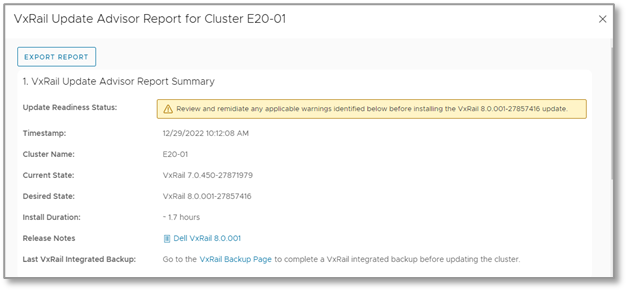
- The update advisory report that provides component-by-component change analysis, which helps users build IT infrastructure change reports:
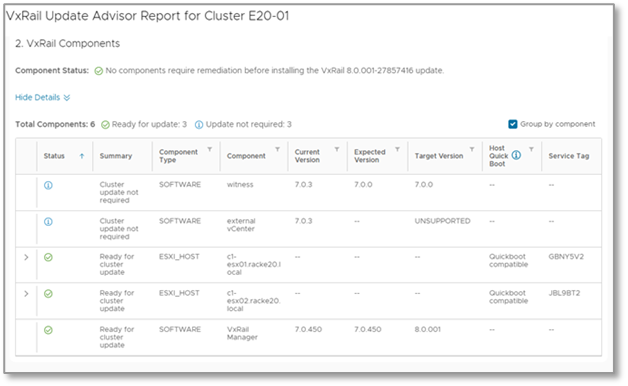
- The health check report that was discussed earlier:
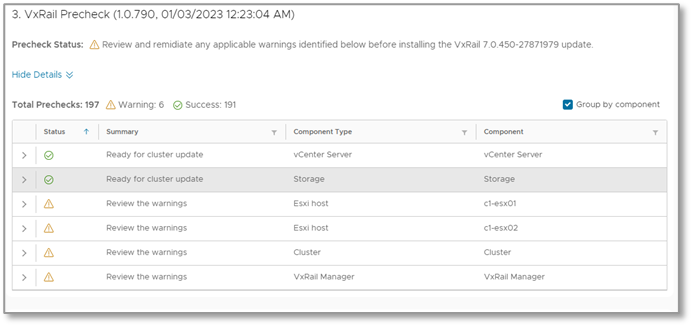
- The user-managed component report that reminds users whether they need to update non-VxRail managed components for a cluster update:

This report is automatically generated every 24 hours so that you can log onto VxRail Manager and have all the up-to-date information at your disposal to make informed decisions. This feature will make your life easier because you no longer have to manually run all these jobs and wait for them to complete!
For a non-recommended update, you can manually generate an update advisor report using the Actions button for the listed update path. For clusters not connected to Dell cloud, you can still benefit from the update advisor report. However, instead of downloading a lightweight manifest file, you would have to download the full LCM bundle from the Dell Support website to generate the report.
Smart bundle
The last life cycle management feature that I want to focus on is about smart bundles. The term ‘smart bundle’ refers to a space-efficient LCM bundle that can be downloaded from the Dell cloud. For VxRail users who are using CloudIQ today to manage their VxRail clusters, this feature is familiar to you. A space-efficient bundle is created by first performing a change analysis of the VxRail Continuously Validated State currently running on a cluster versus the target VxRail Continuously Validated State that a user wants to download for their cluster. The change analysis determines the delta of install files in the full LCM bundle that is needed by the cluster to download and update to the target version.
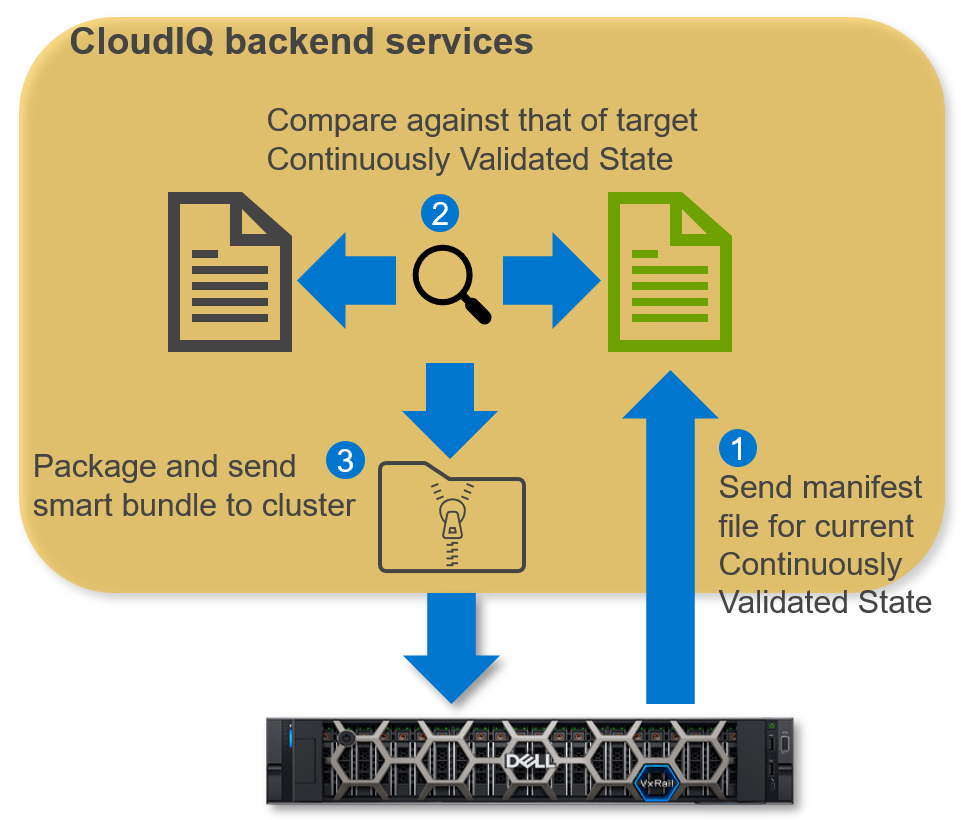
In VxRail 7.0.450, you can now initiate smart bundle transfers from VxRail Manager. Smart bundles can greatly reduce the transfer size of an update bundle, which can be extremely beneficial for bandwidth-constrained environments. To use the smart bundle feature, the cluster has to be configured to connect to CloudIQ in the Dell cloud. If VxRail Manager is not properly configured to use the smart bundle feature or if the smart bundle operation fails, VxRail Manager defaults to using the traditional method of downloading the full LCM bundle from the Dell cloud.
VxRail dynamic nodes with PowerStore
VxRail 7.0.450 introduces the much-anticipated integration of PowerStore life cycle management into VxRail Manager for a configuration consisting of VxRail dynamic nodes using PowerStore as the primary storage (also referred to as Dynamic AppsON). This integration further centralizes PowerStore management onto the vCenter Server console for VMware environments. With the Virtual Storage Integrator (VSI) plugin to vCenter, you have been able to provision PowerStore storage and manage data services. Now, you can use the VxRail Manager plugin to manage a PowerStore update and view the array’s software version.
To enable this functionality, VxRail leverages the VSI’s new API server to communicate with the PowerStore Manager and initiate lifecycle management operations and retrieve status information. The API server was developed exclusively for VxRail Manager in a Dynamic AppsON configuration. You start the LCM workflow by first uploading the update bundle to PowerStore Manager, then running an update pre-check, and lastly running the update. The operations are initiated from VxRail Manager but the actual operations are executed on the PowerStore Manager.
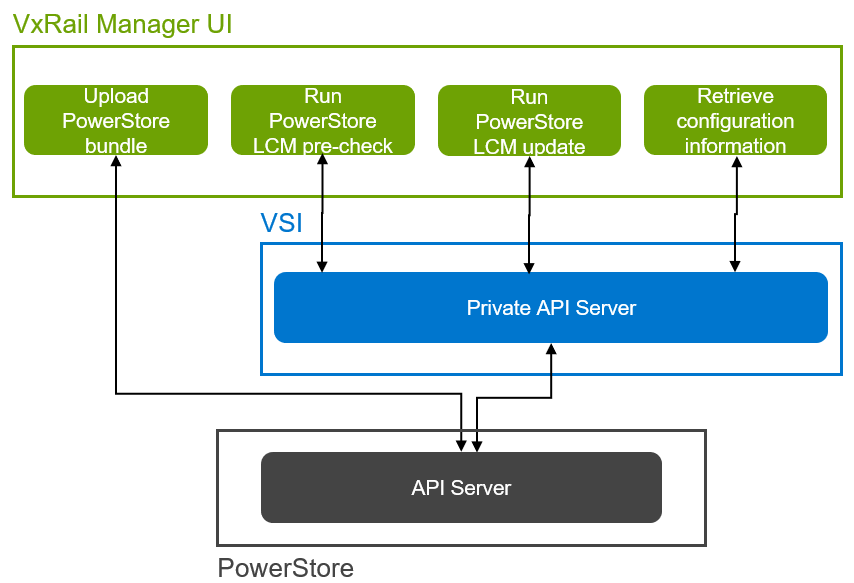
The following video shows the PowerStore LCM workflow that can be run from the VxRail Manager. You can update a PowerStore that is using any storage type, except NFS, as the primary storage for a VxRail dynamic node cluster.
Conclusion
Although VxRail 7.0.450 is a jam packed release with many new features and enhancements, the features I’ve described are the headliners and deserve a deeper dive to unpack the capability set. Overall, the set of LCM enhancements in this release provides immense value for your future cluster management and update experience. For the full list of features introduced in this release, see the release notes. And for more information about VxRail in general, check out the Dell VxRail Hyperconverged Infrastructure page on www.dell.com.
Author: Daniel Chiu

Adding to the VxRail summer party with the release of VxRail 7.0.010
Wed, 24 Apr 2024 11:53:27 -0000
|Read Time: 0 minutes
After releasing multiple VxRail 4.7 software versions in the early summer, the VxRail 7.0 software train has just now joined the party. Like any considerate guest, VxRail 7.0.010 does not come empty handed. This new software release brings new waves of cluster deployment flexibility so you can run a wider range of application workloads on VxRail, as well as new lifecycle management enhancements for you to sit back and enjoy the party during their next cluster update.
The following capabilities expand the workload possibilities that can run on VxRail clusters:
- More network flexibility with support for customer-supplied virtual distributed switch (VDS) – Often times, customers with a large deployment of VxRail clusters prefer to standardize their VDS so they can re-use the same configuration on multiple clusters. Standardization simplifies cluster deployment operations and VDS management and reduces errors. This is sure to be a hit for our party guests with grand plans to expand their VxRail footprint.
- Network redundancy – the support for customer-supplied VDS also enables support for network card level redundancy and link aggregation. Now you can create a NIC teaming policy that can tolerate a network card failure for VxRail system traffic. For example, the policy would include a port on the NDC and another port on the PCIe network card. If one network card becomes unavailable, the traffic can still run through the remaining network card. With link aggregation, you can increase the network bandwidth by utilizing multiple ports in an active/active network connection. You can select the load balancing option when configuring the NIC teaming policy.
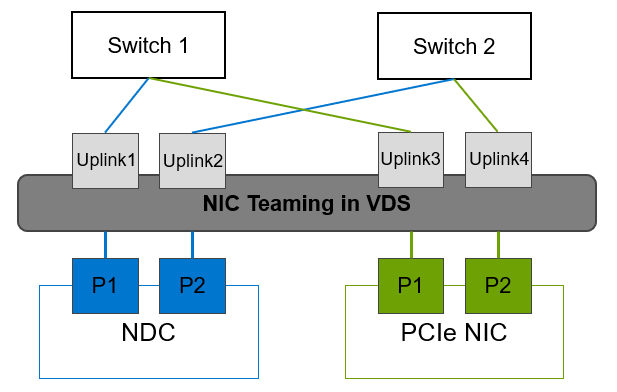
Network card level redundancy with active/active network connections
- FIPS 140-2 Level 1 validated cryptography – Industry sectors such as the federal sector require this level of security for any applications that access sensitive data. Now the VxRail software meets this standard by using cryptographic libraries and encrypting data in-transit and storage of keys and credentials. Combine that with existing vSAN encryption that already meets this standard for data at rest, VxRail clusters can be a fit for even more environments in various industry sectors with higher security standards. The guest list for this party is only getting bigger.
Along with these features that increase the market opportunity for VxRail clusters, lifecycle management enhancements also come along with VxRail 7.0.010’s entrance to the party. VxRail has strengthened in LCM pre-upgrade health check to include more ecosystem components in the VxRail stack. Already providing checks against the HCI hardware and software, VxRail is extending to ancillary components such as the vCenter Server, Secure Remote Services gateway, RecoverPoint for VMs software, and the witness host used for 2-node and stretched clusters. The LCM pre-upgrade health check performs a version compatibility against these components before upgrading the VxRail cluster. With a stronger LCM pre-upgrade health check, you’ll have more time for summer fun.
VxRail 7.0.010 is here to keep the VxRail summer party going. These new capabilities will help our customers accelerate innovation by providing an HCI platform that delivers the infrastructure flexibility their applications require, while giving the administrators the operational freedom and simplicity to fearlessly update their clusters freely.
Interested in learning more about VxRail 7.0.010? You can find more details in the release notes.
Daniel Chiu, VxRail Technical Marketing


